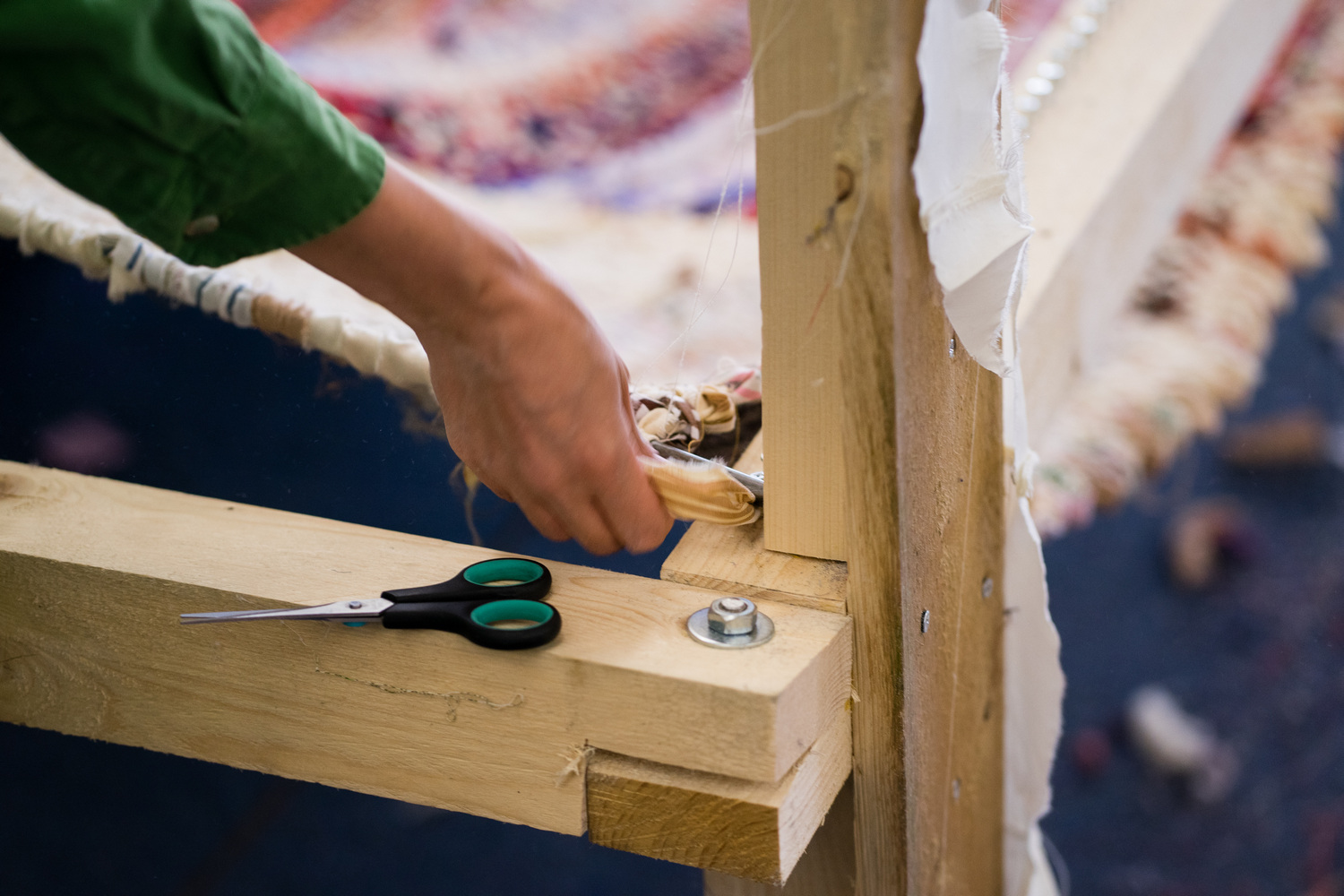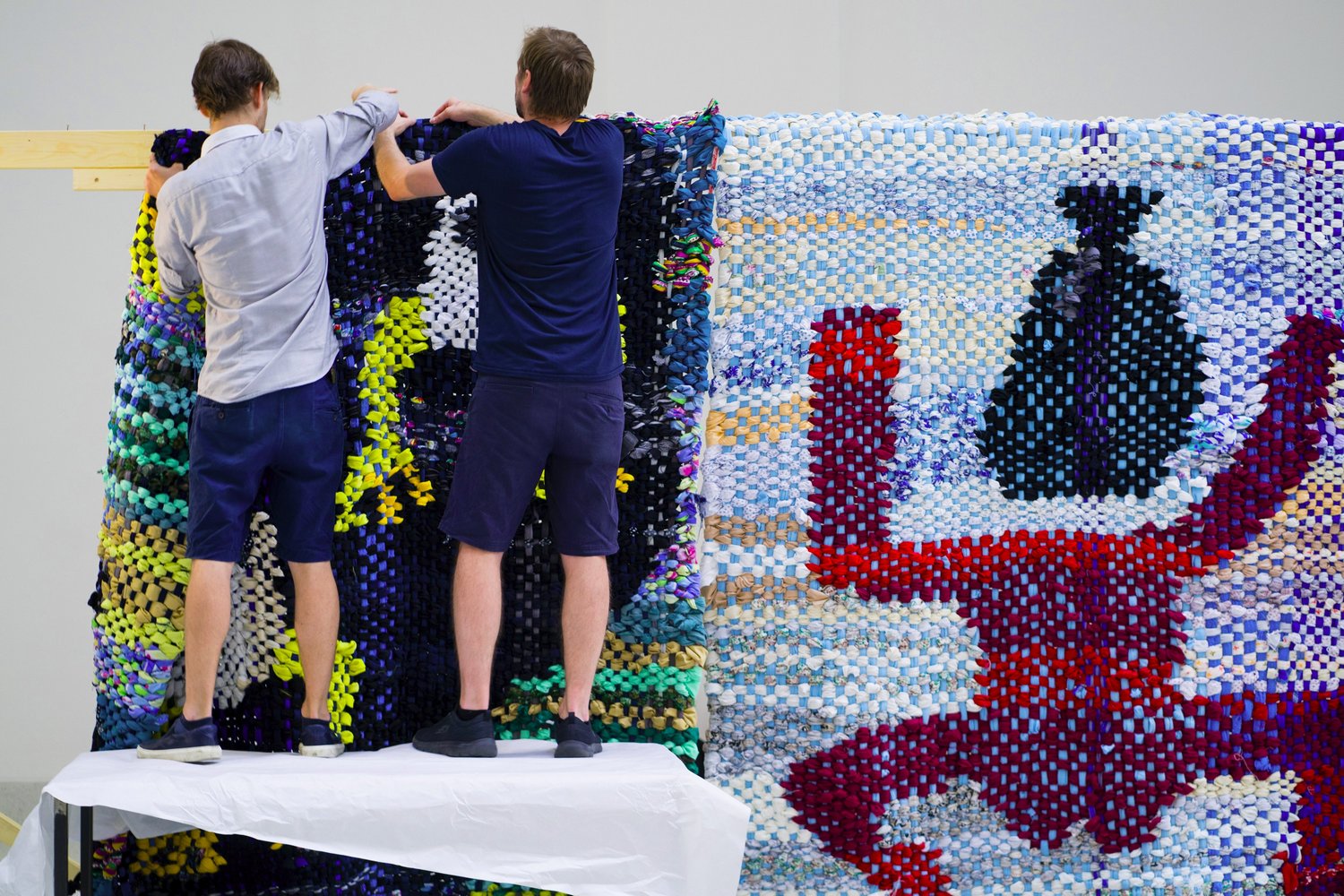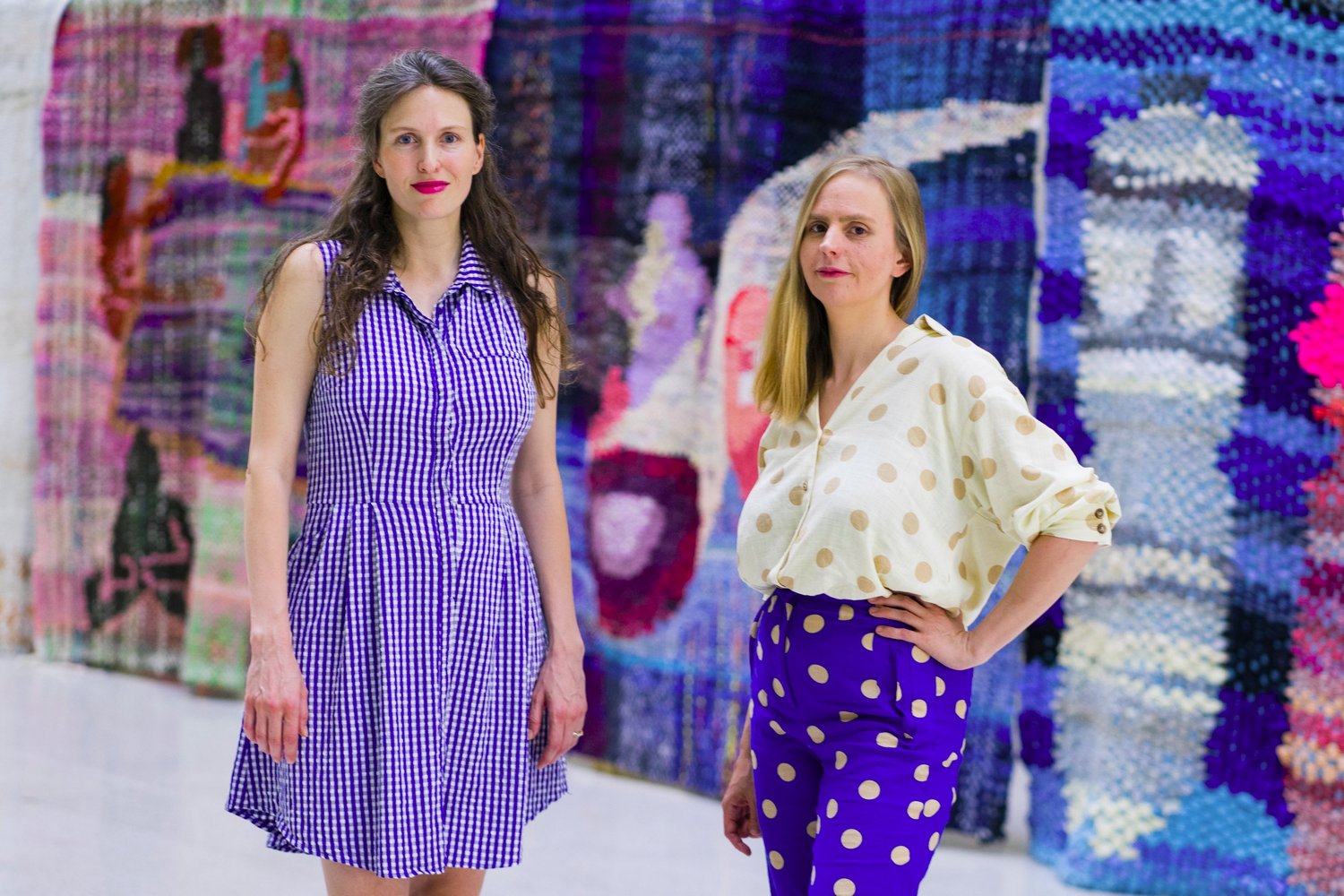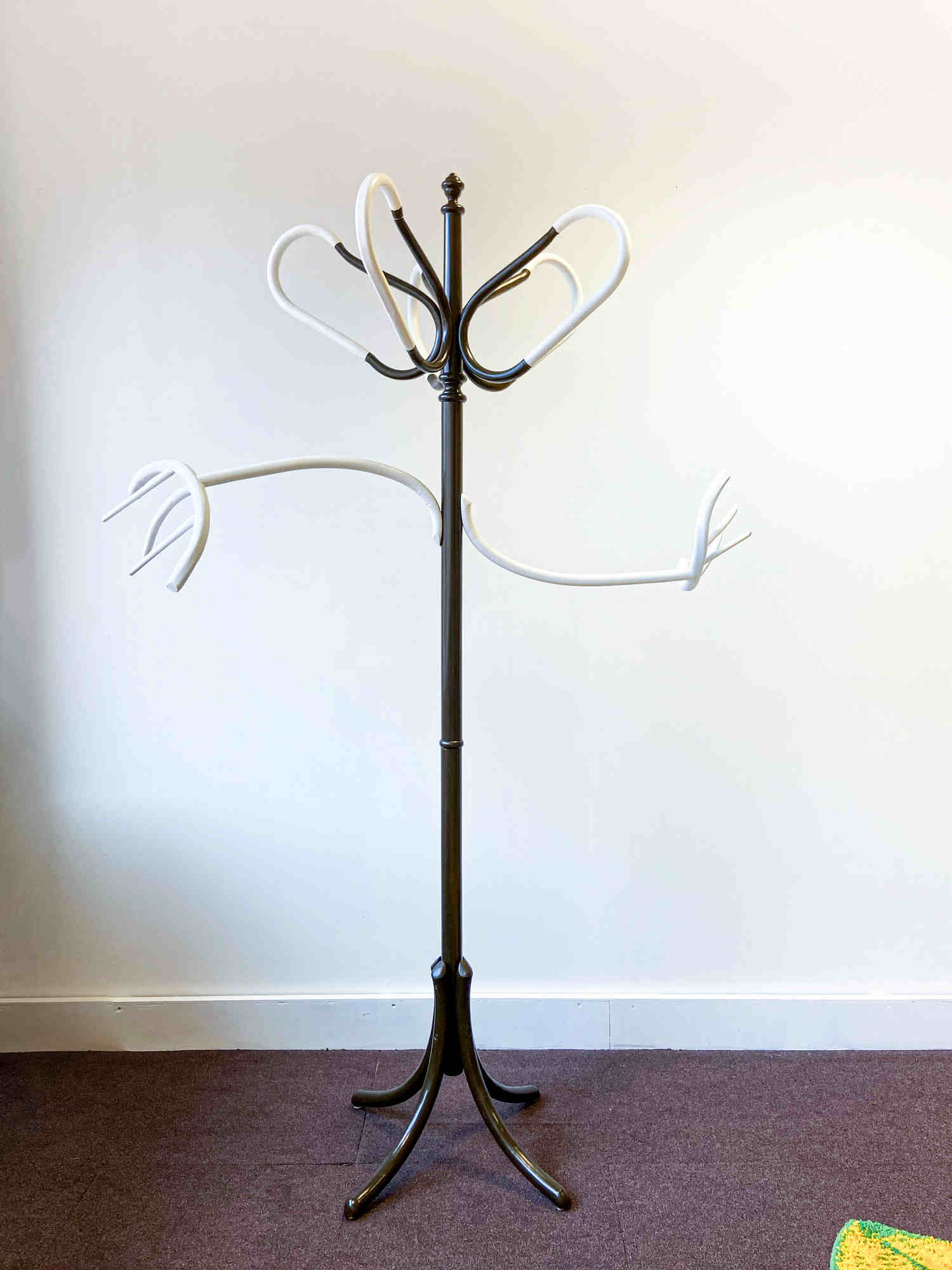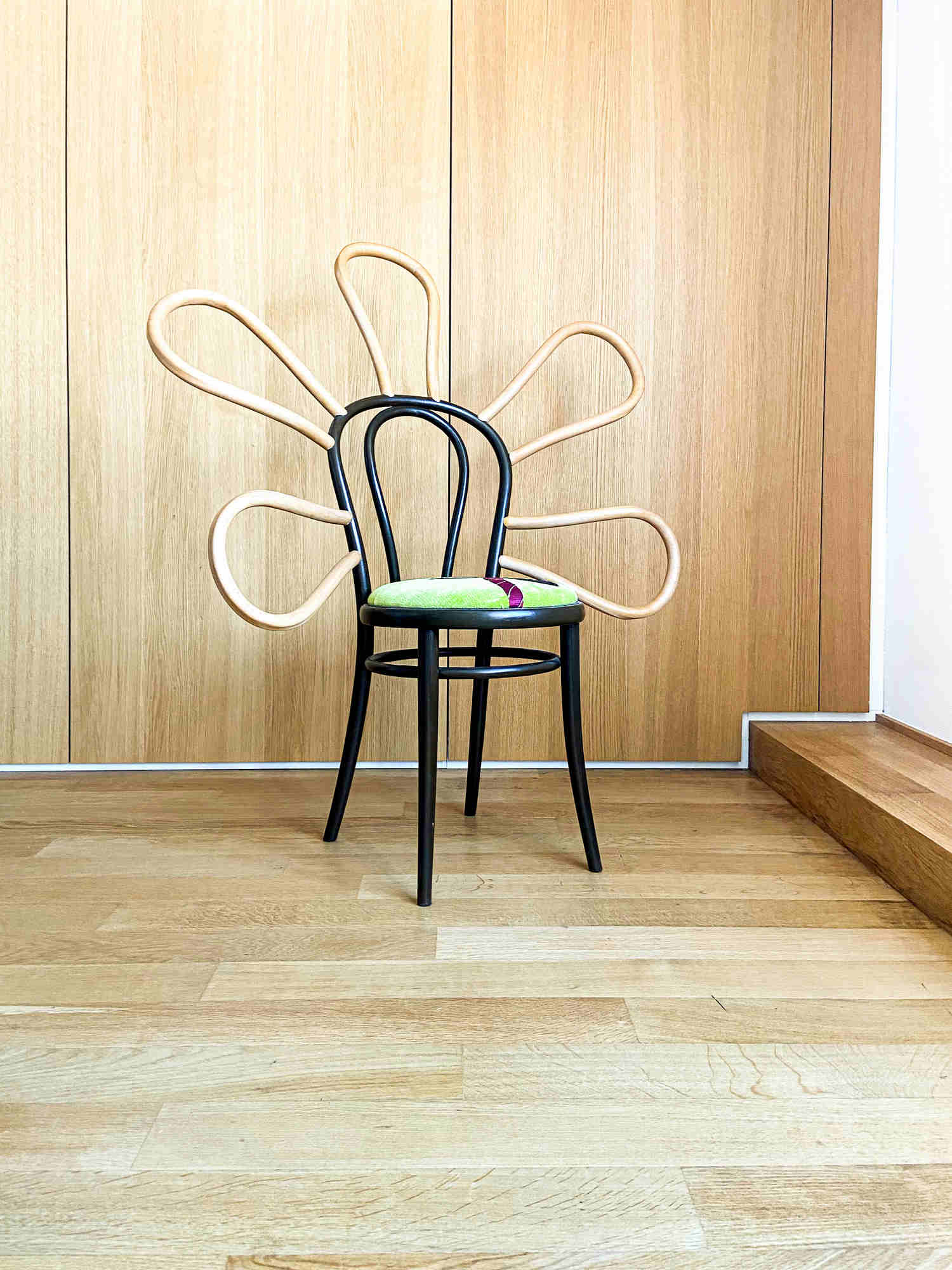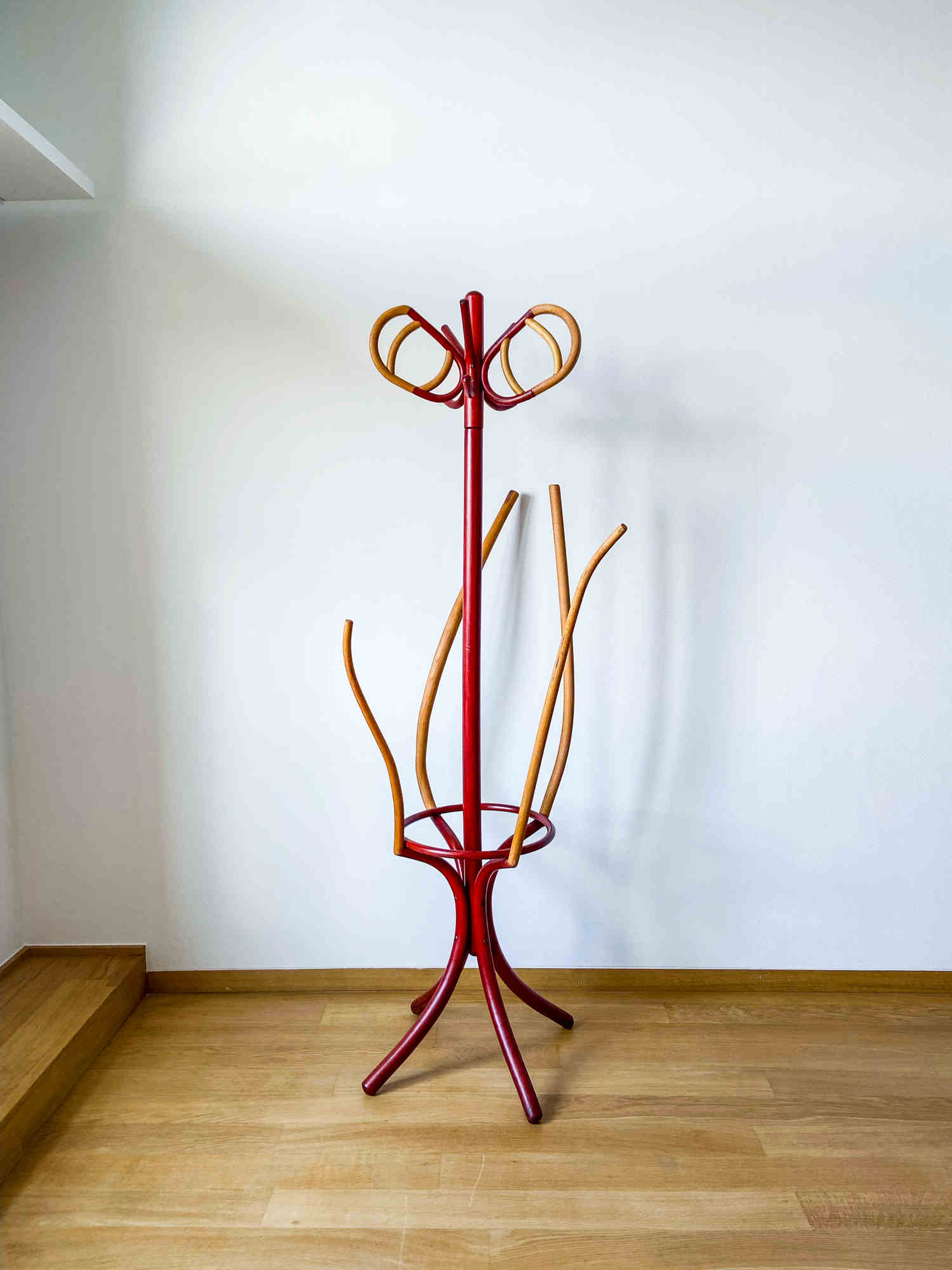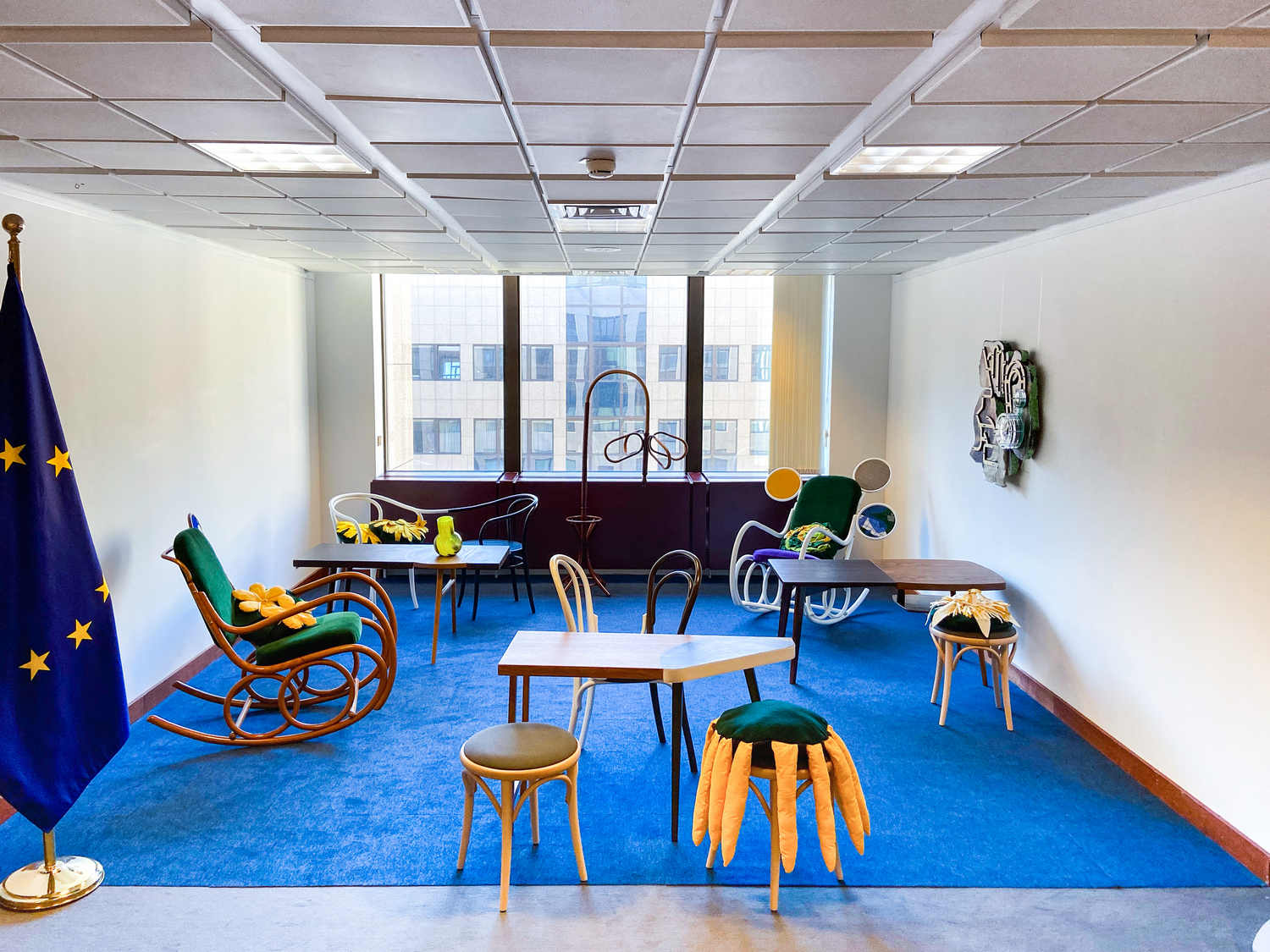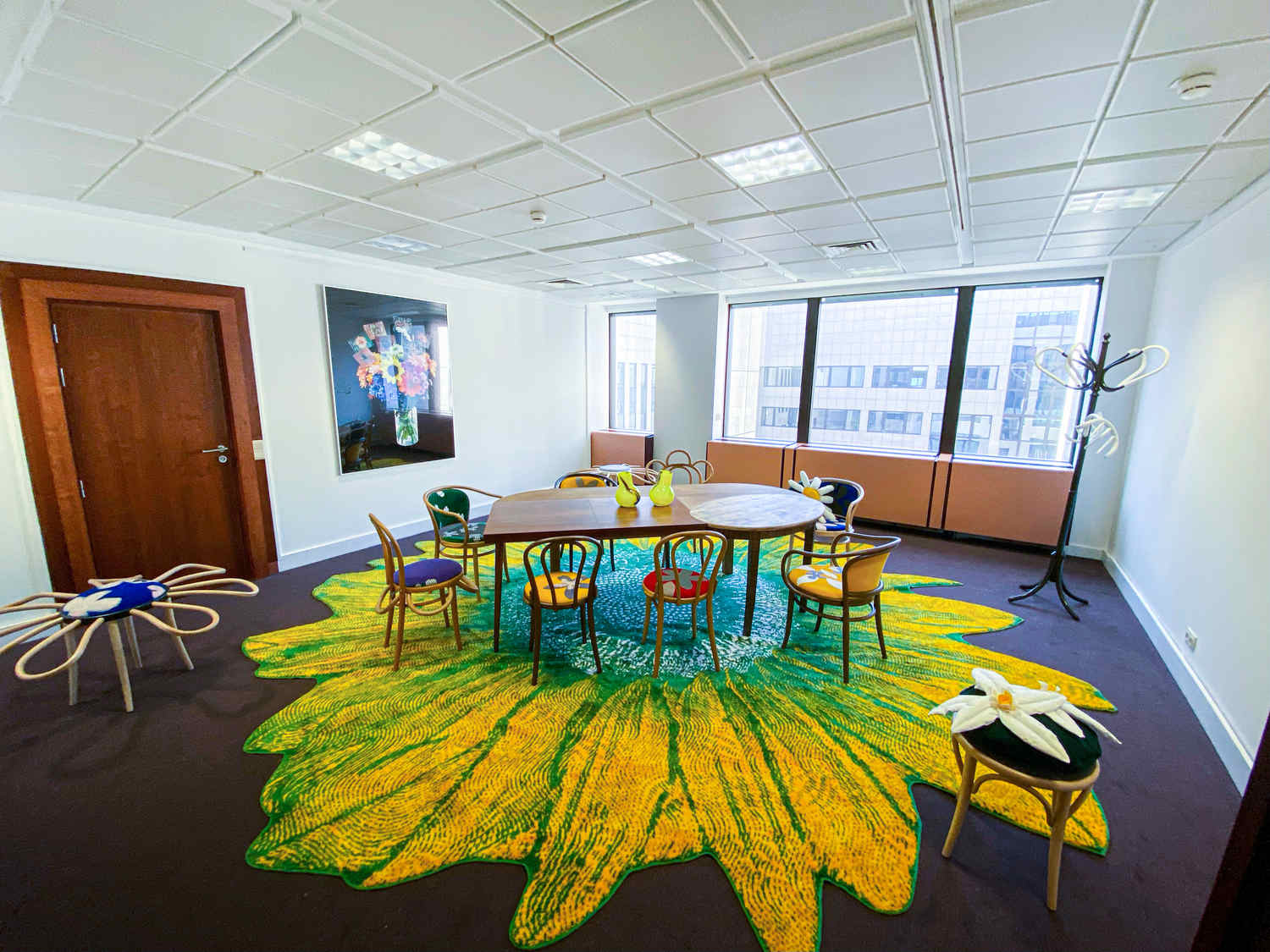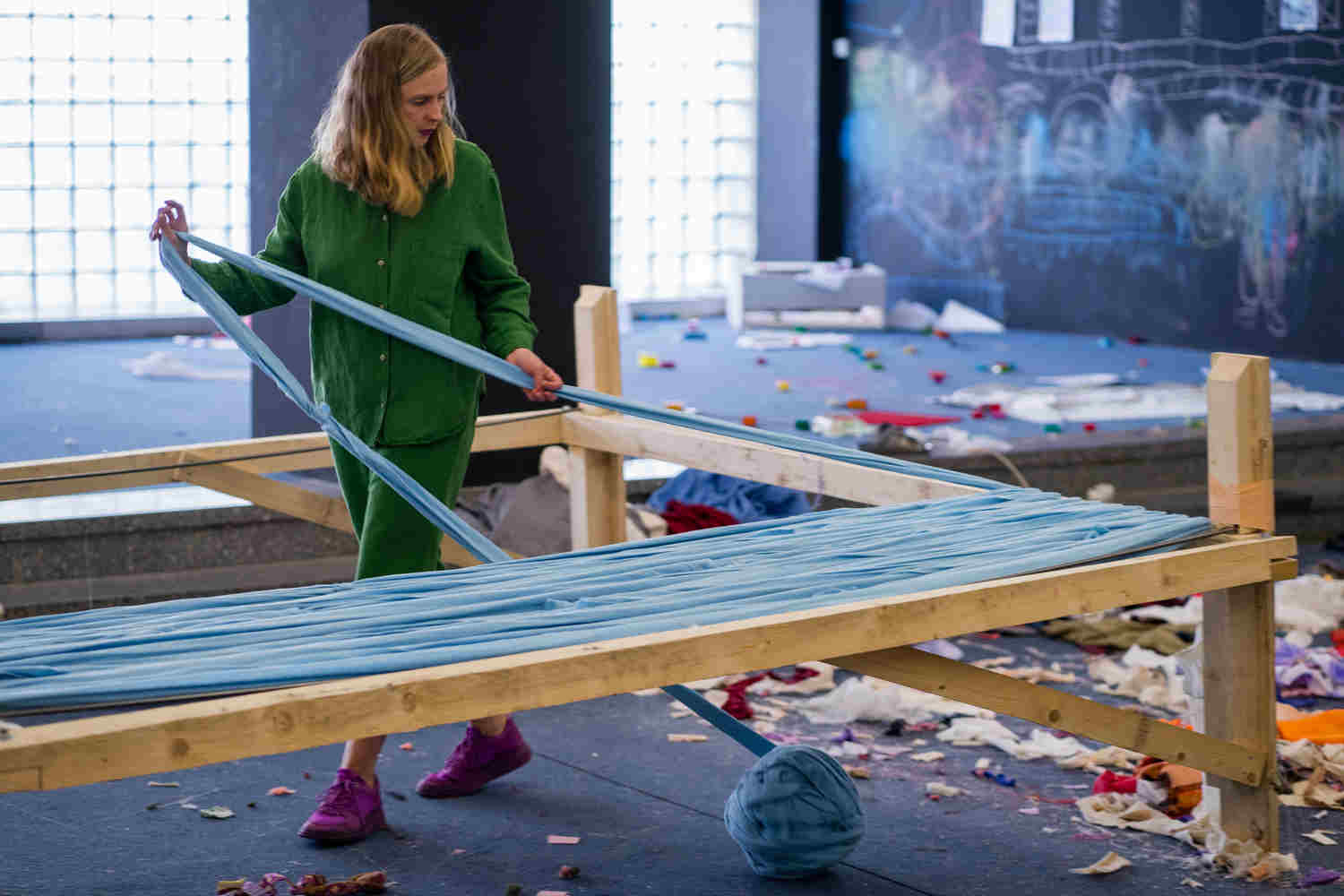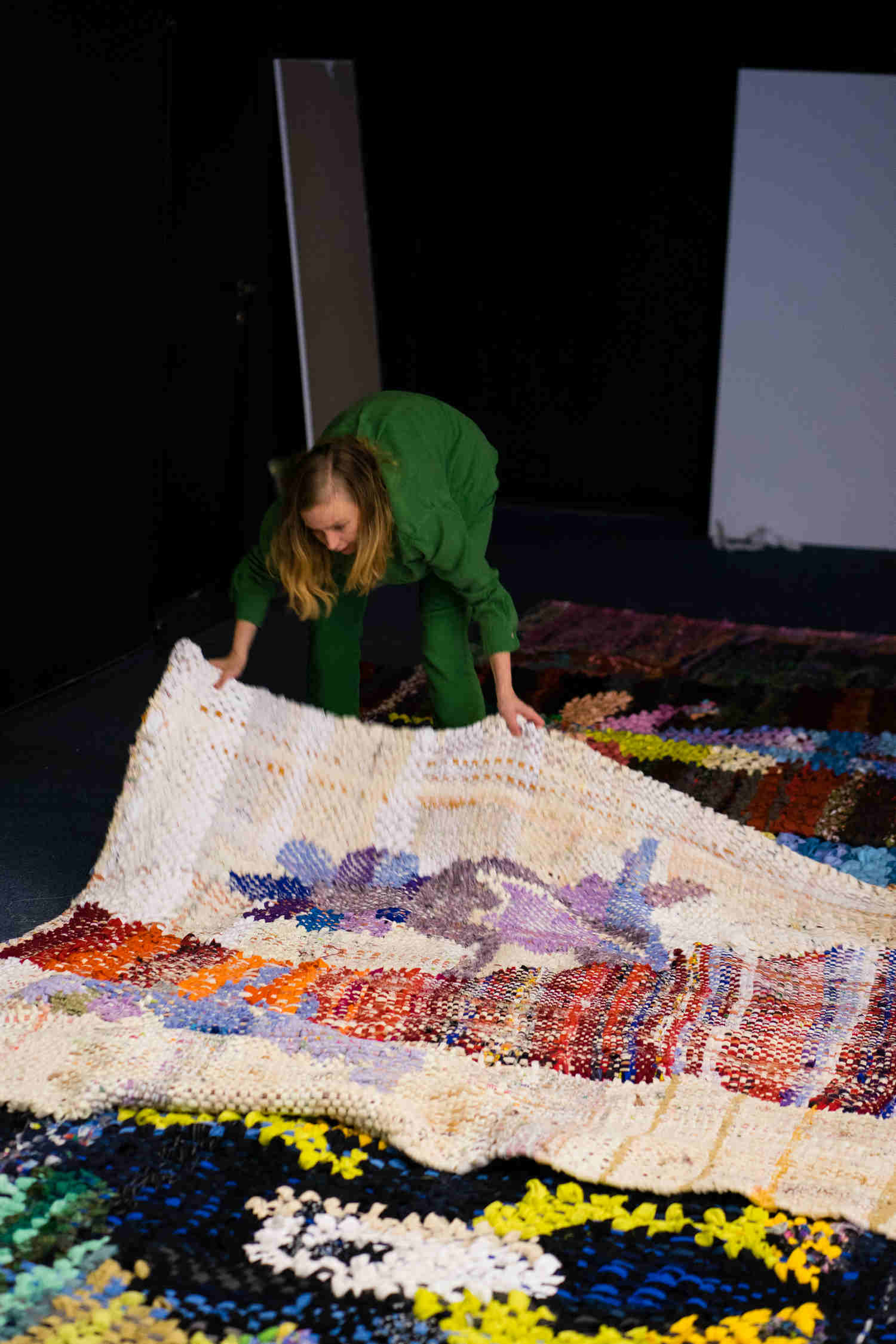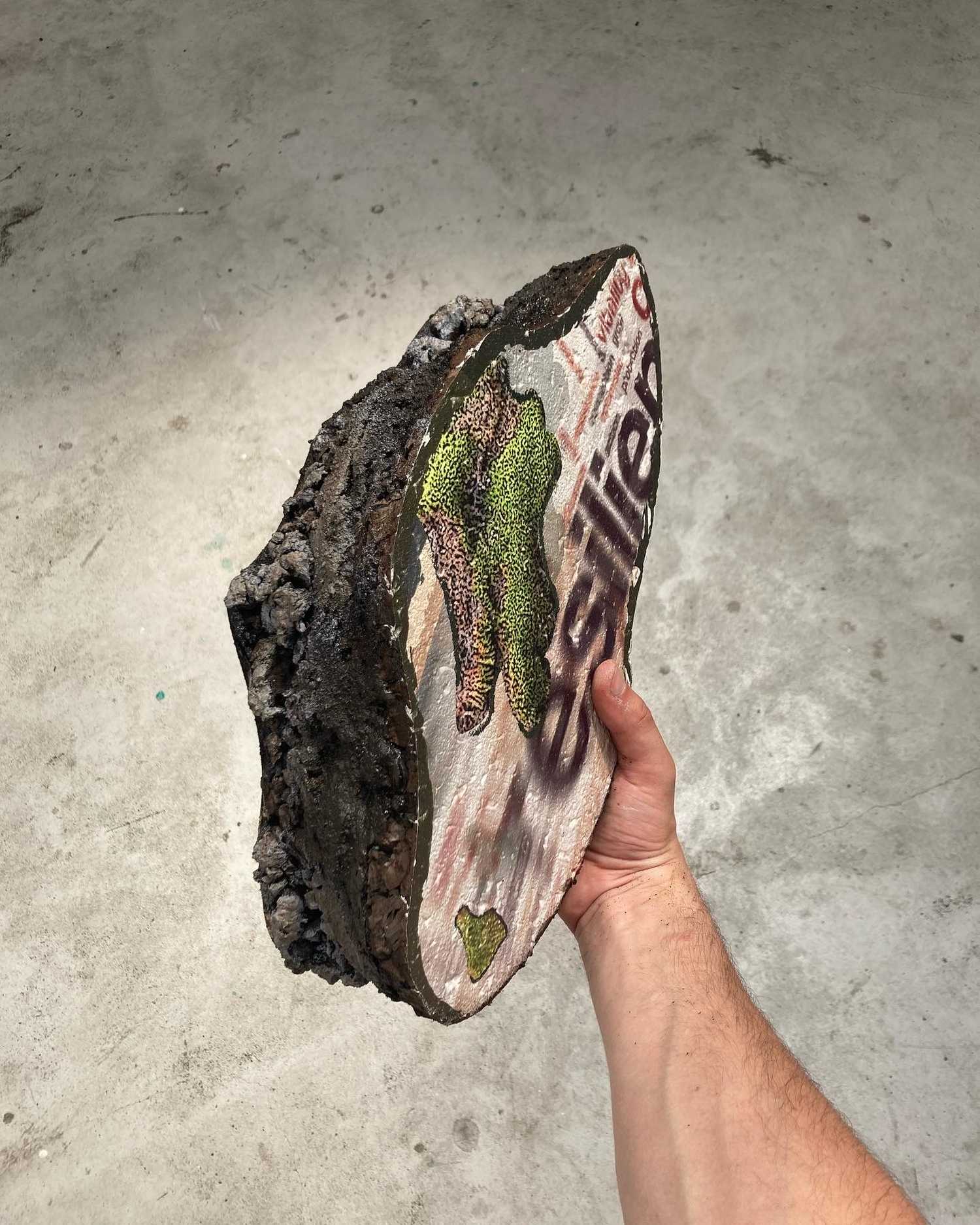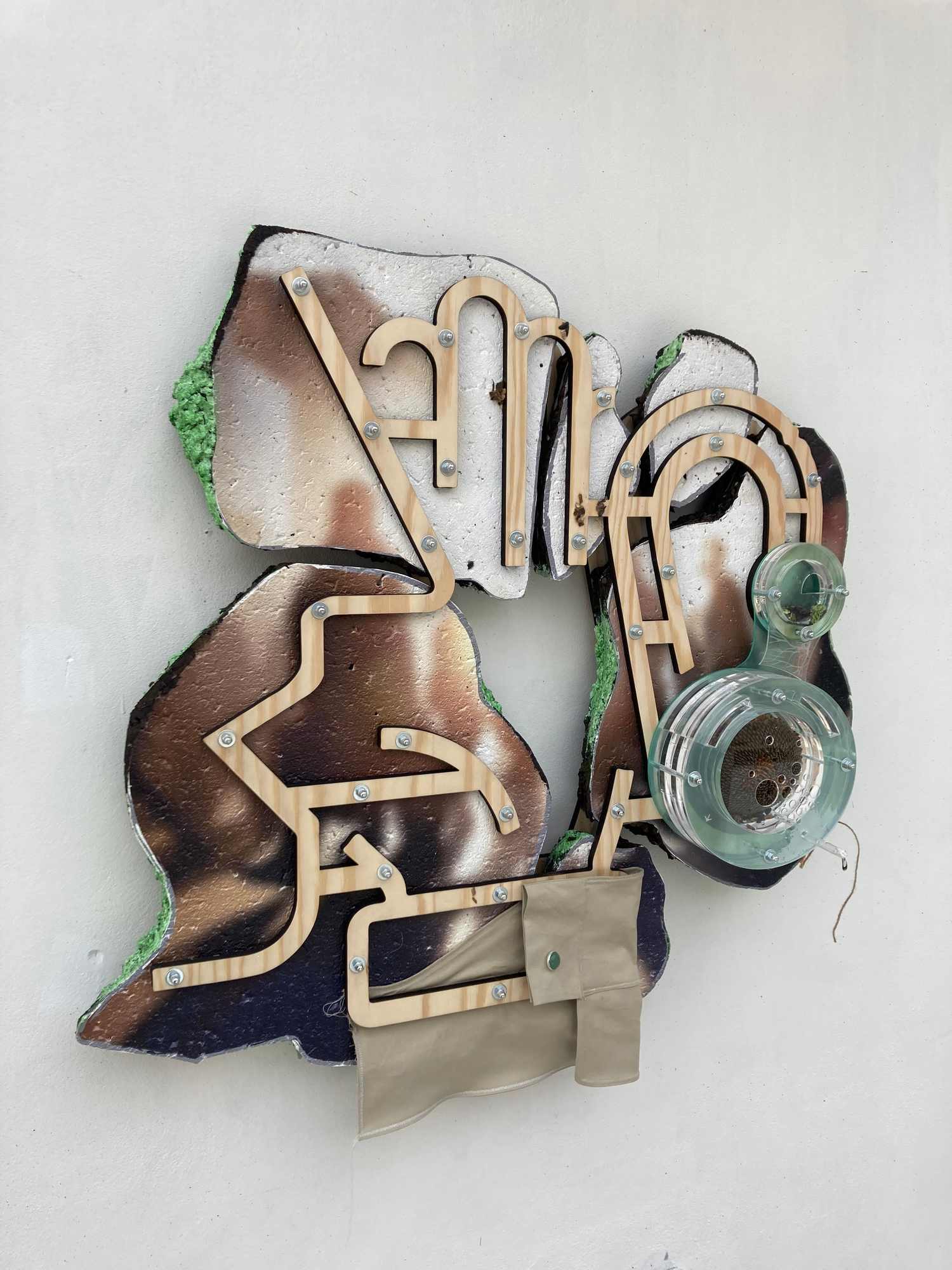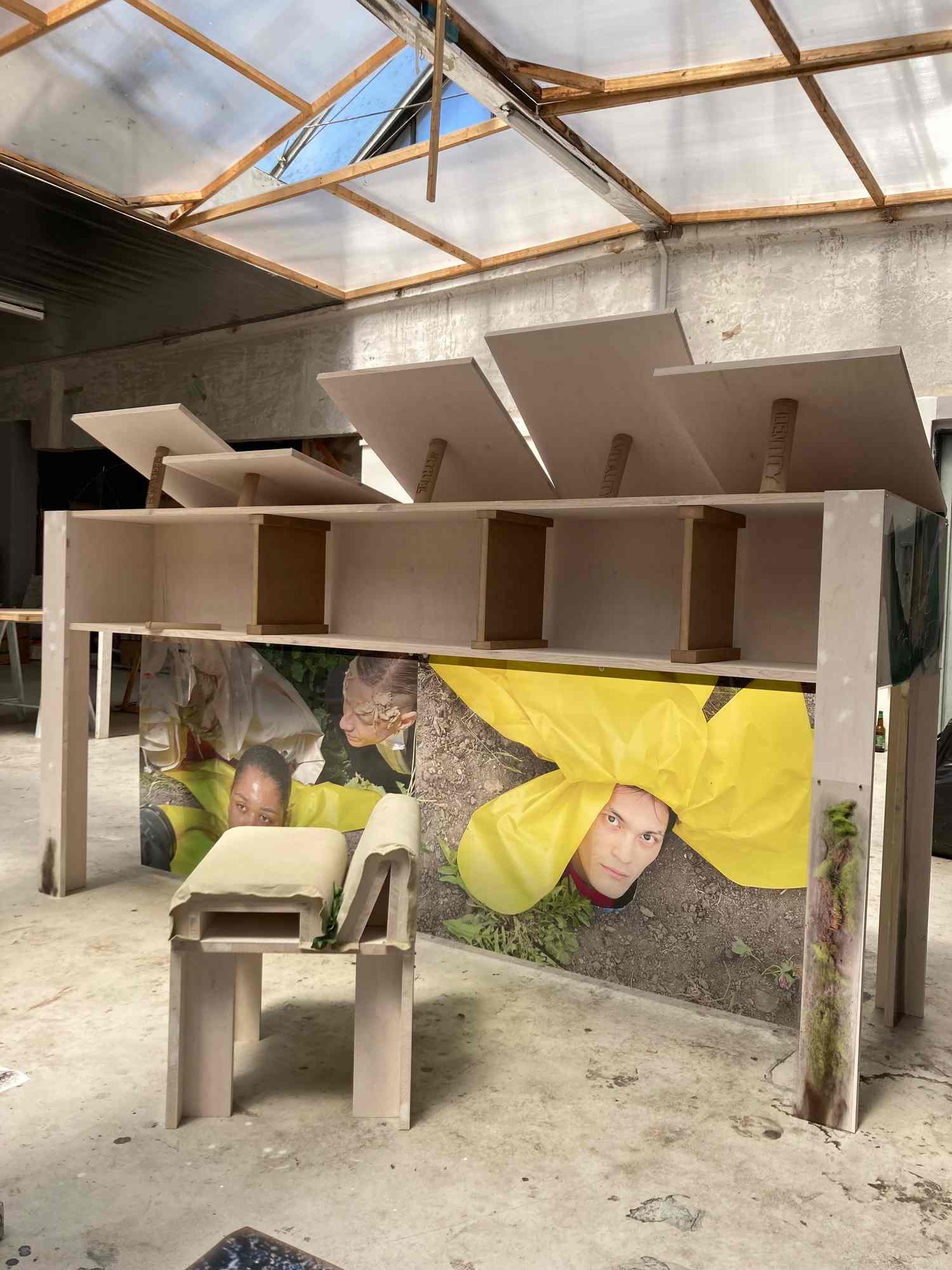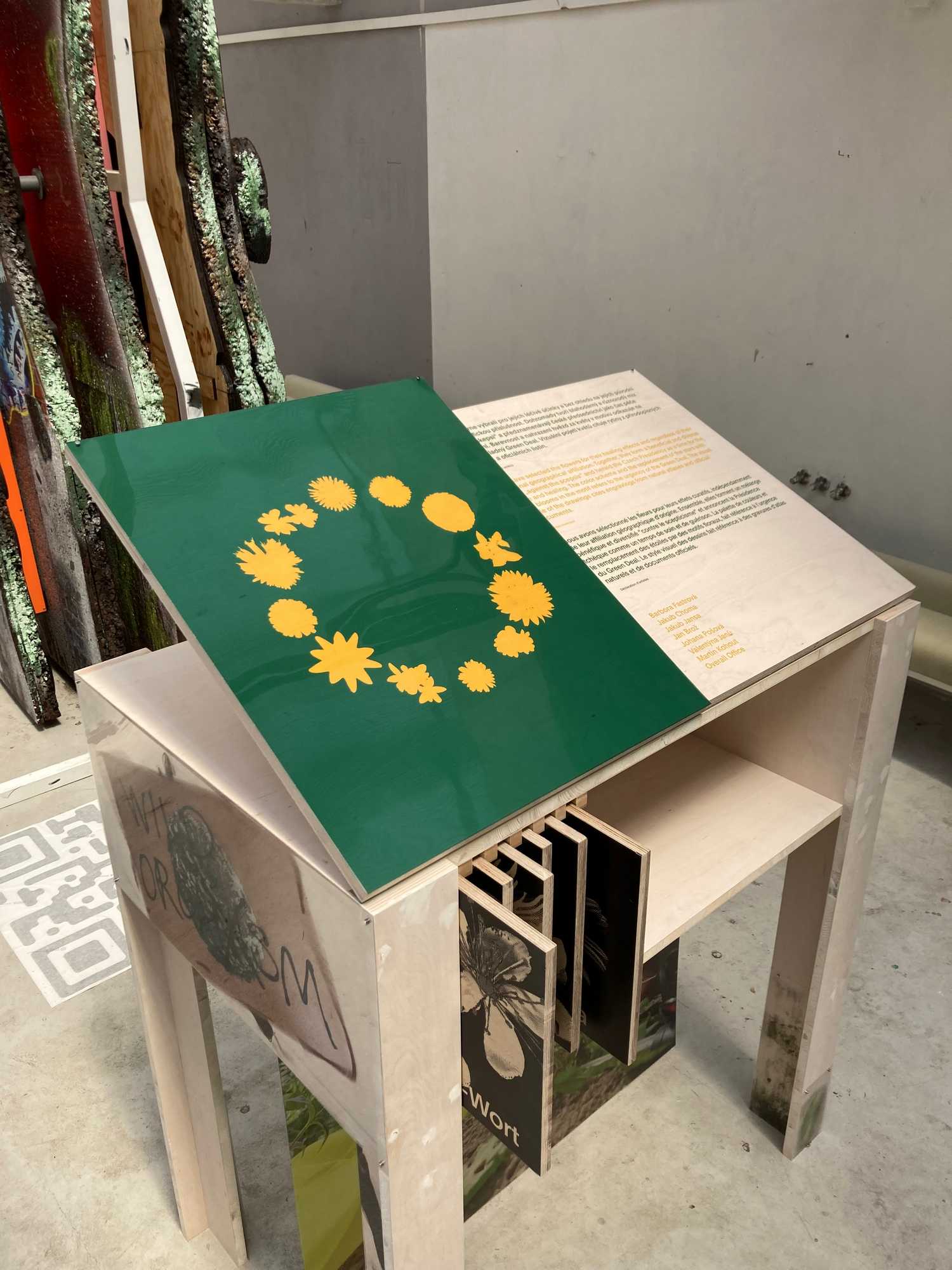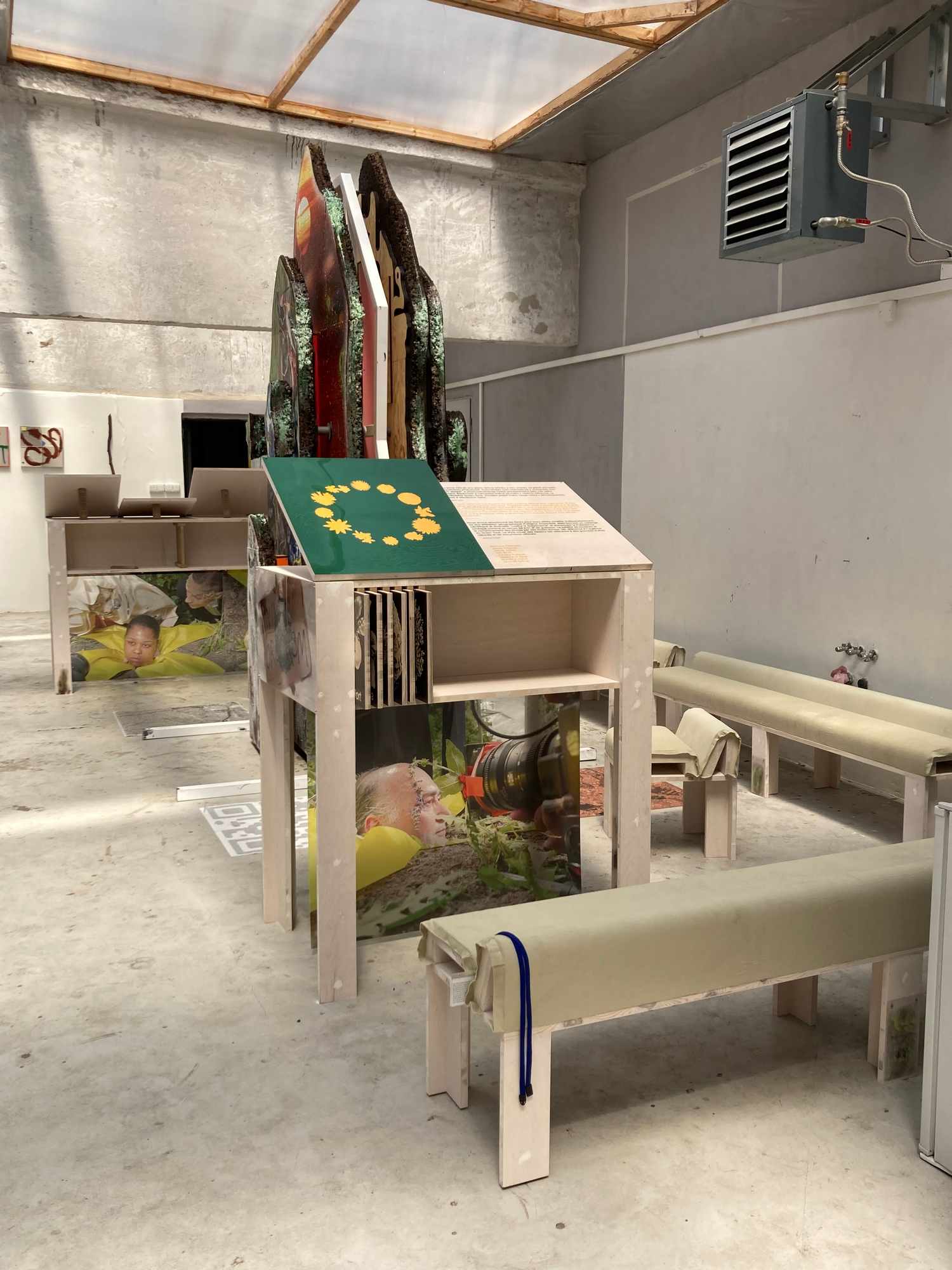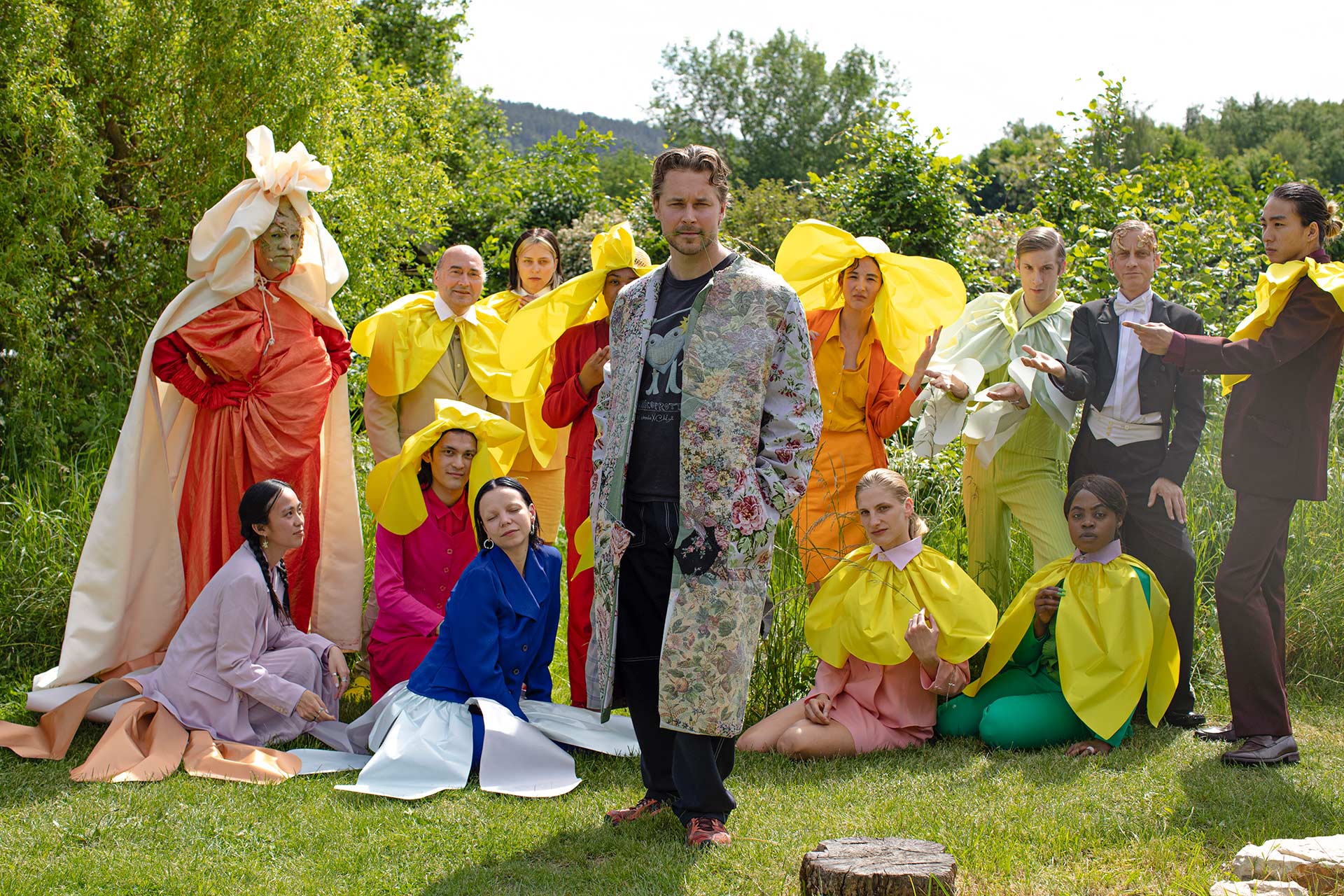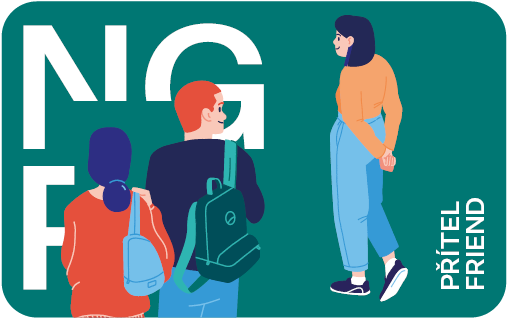
Flower Union
The main symbol of the Czech Presidency is a wreath of twelve medicinal plants, and this has been incorporated in the design of the large, ecologically-manufactured carpet installed in the main area of the atrium in the building where Council meetings are held. The weaving of wreaths is an ancient, not only Slavic, tradition. Young unwed women cast wreaths into the river during the solstice to guarantee their romantic future. This symbolised not only the vitality of youth but also the natural continuation of life after leaving one’s home hearth. In keeping with the main symbol for the artistic presentation of the Czech Presidency, the artists chose to replace the twelve gold stars on the EU flag with twelve medicinal plants from different European regions. The resulting wreath, in which the stems of each plant are twisted around those of the previous one to create a more interwoven and stronger bond, embodies a gesture promoting a stronger European togetherness between all of the EU’s unique and distinct regions. A union, which does not exclude local identities, folklore, or traditions.
The floral motif is, however, also an ecological appeal, particularly within the context of Russia’s war on Ukraine and the approaching energy crisis, which has become one of the main themes of the Czech Presidency. The blue background of the flag has thus been replaced with a green one. The history of the flag of the European Union dates back to 1955, to the time of the European Coal and Steel Community, which had only six member states. And so the motif has been transformed from glowing stars in a distant sky to a community of flowers in a buzzing summer meadow.
The metaphor of the wreath is also pointed at the Czech nation itself, and its tendency to be sceptical towards big ideas from outside. The substitution of flowers for the stars is a gesture, intended to help the Czechs to plausibly communicate the European concept of “unity in diversity”. It should also facilitate a better understanding of ecological transformation through the warm and positive relationship Czechs have with nature. At the same time, since the Czech Republic celebrated its eighteenth year of EU membership this year, it draws attention to the country’s transition into adulthood and its ensuing responsibilities. Even in the distant past, in the “Prague Appeal” of 1985, Václav Havel and other Charter 77 signatories spoke about a Europe unified through a common spiritual foundation as of a beam of hope for all the citizens of totalitarian countries. This hope is once again very pertinent today and, given the current Russian aggression, maybe even the most pertinent since the fall of totalitarian countries in 1989. It was also Václav Havel who spoke about the need to sacrifice a part of one’s personal happiness for the benefit of higher ideals, and it was he who reminded the world of the worsening state of the environment. He also repeated that it can only be the “European spirit” that will help Czech society to overcome the deep-rooted fear of other people. In one of his last interviews, one of the things he mentioned was that the admission of Ukraine and Belarus to the European Union might be one possible future development of Europe.
The themes of “a common fabric” and “interweaving” may also be found in the large tapestry made for the press room area by Barbora Fastrová and Johana Pošová. The tapestry, hand-made from cut pieces of second-hand textile over the course of an intensive six months, uses a deliberately epic manner to depict the process of recycling plastic bottles into textile fibres. The Overall Office fashion design team used these types of fibres and other residual fabrics to make the materials that Johana and Barbora employed to make the seat cushions.
The chairs, tables, and stools used in the waiting areas and meeting rooms of the Council building are modified pieces of old and new furniture made from bentwood, which is a typical material used in Central Europe. The use of wood scraps and shavings help the individual pieces of furniture to come together, interweaving and expanding them, thus evoking the concept of interconnectedness and the resulting need to engage in a dialogue.
The collection of objects made by Jakub Choma, in collaboration with Tomáš Kocka Jusko and Alex Selmeci, serves as a meeting place – the info-centre of the entire project – a library, as well as a place to sit down for visitors waiting in the area just beyond the turnstiles until they are met by a staff member. The main object, a monolithic shape partially created from layers of natural cork, forms an association between layers of images and ideas. Even in the other installations, Choma utilises something akin to materialised information, somewhere between a real and a symbolic object, in which ideas expressed in both pictures and words are inscribed in each layer of the functional furniture.
The entire project is accompanied by a website which – as well as the graphical representation of the flowery flag – was designed by Jan Brož. This campaign also includes three videos. In the first, Martin Kohout works with a computer-generated image that uses inner rhythms to connect the image of flowers floating on a river with a flowing stream of pedestrians.
The second, by Valentýna Janů, presents three connected feature clips, which play with the options of false dichotomy and the borders between dualisms, such as between private and public, individual and global, or hope and pessimism. The clips suggest that the dilemmas associated with these opposites may be false. Then in the third, in his staged video, Jakub Jansa uses allegory, a fairy-tale approach and humour to present the adventures of his protagonist – a hybrid of a man and celery – to help to overcome scepticism at a garden party. This humorous video also shows viewers what life would be like if there were no European Union. The costumes for the projects of both Jakub Jansa and Valentýna Janů were once again made by Overall Office by combining remnants left over from making shirts, ties, and evening jackets with recycled textile fibres. They utilised the unique art protis technique, which was developed in 1960s Czechoslovakia.

1 Kopretina 2 Neroli 3 Mučenka 4 Měsíček 5 Aloe Vera 6 Třezalka 7 Smetánka 8 Kozlík 9 Aksamitník 10 Bougainvillea 11 Slunečnice 12 Portulaca

Flower Union, floral connection
Jan Brož, in collaboration with other artists of the Flower Union project, created an allegorical concept of the official flag of the European Union. The circle of stars transformed into a wreath on a green background leads to a reflection on the power of the natural world over the human one. In the superpower of plants to be reborn only from their underground part, this realm rises in some ways high above human society. The wreath of flowers joining together to save the world may be equivalent to a more natural version of a supernatural grouping like the Guardians of the Universe or the Fellowship of the Ring, but in this case it is not seeking to destroy the ring of evil, but rather to create a floral ring of goodness encircling our planet.
The plants chosen for the symbolic circle are therefore meant to suggest a combination suitable for an imaginary tea potion against despair and scepticism, full strength of a "Flowering Meadow" type tea blend. The power to influence our history in the best sense of the word, the power of climbing plants to cover up fallen plaster and holes in walls, the power to purify the air that we can only pollute, the power that comes from the ecosystem's instinct for self-preservation, which people often resist in the name of power and profit. Yet the two worlds are irreversibly linked. When nature falls, man falls.
One of the flowers depicted in the project - sunflower - the national flower of Ukraine - expands into the presidential lounge, the space where the meetings of the highest officials take place. The carpet with its fine high pile will thus hopefully remind politicians under their feet not to forget the suffering of Ukraine.

Jan Brož
Flower Union
12 carpets pieces
Collaboration: Valentýna Janů, Overall Office, Barbora Fastrová, Jakub Choma, Jakub Jansa, Johana Pošová, Martin Kohout, and Michal Novotný Novotný
Manufacturing: Grund CZ

The flourishing of textile waste
The artistic duo Pošová and Fastrová have been working on sustainability for the last few years of their almost decade-long collaboration. This is also reflected in the tapestry woven from textile waste. The fabrics used come from second-hand clothing and linens and from factories where the fabric residues would have been discarded.
The scene stitched into the fabric illustrates not only its creation itself, but also the metamorphosis between man, plant and waste. Thanks to the self-illustrative content, aside the environmental appeal, an even more personal topic od the two artists mothers had sneaked into the depicted themes: motherhood. Also in the allegorical sense of mother earth giving life.
The tapestry took the artists more than six months to be made by hand. They started by cutting and weaving strips of fabric, which are then woven together one by one on a grid. The work, with its handmade, homespun aesthetic, creates a functional contrast to the clean, stripped-down space of the representative hall.
Morphing furniture
The iconic Czech company TON was approached by the designers based on its strong tradition and ubiquity not only across Czech households, but also in public spaces. Partly new and partly upcycled from second-hand stores, new and second hand furnitures morphs when combined with the waste from factory production into the shapes and forms of animated, growing flora. Chairs and armchairs become sculptural objects between fine and applied art. The artists put the different pieces together like individual puzzle pieces. The atypical jigsaw puzzle is completed with new upholstery - fabrics woven with a unique Czech art protis technique grasped by the Overall Office brand. This technique allows collage-like combination of different shapes into one layer of fabric.
The authors also play with the boundary between functional furniture and art. Some pieces still retain a comfortable seating function, others become thanks to the increasing interpenetration of organic shapes mere sculptures to visually admire. At the same time, individual shapes encourage and sometimes even physically enforce physical proximity and face-to-face dialogue.
The project is thus once again a reminder of the necessity not to forget the ecological themes, which here emerge fantastically, in a surreal shift, even from the most common, normally invisible objects of office furnishings - stools, chairs, armchairs and coat hangers. At the same time, it points to a kinship with nature, the necessity of dialogue and listening, which should not be avoided even in isolated office spaces with their own well-maintained climate.
1—1 / 10
Johana Pošová & Barbora Fastrová
Breasts, Children, Creatures, and Waste
Handmade tapestry from discarded textiles 2022
Johana Pošová & Barbora Fastrová
The Furniture
Bent wood, upcycled wooden furniture, textile
Manufacturing: Před–po (Jan Švéda & Martin Labík)
Upholstery: Overall Office & Kristýna Bratinková 2022

Non-accidental connections
Jakub Choma, finds the entry point of his inspiration in the motif of "meeting stone", which is a virtual monolithic object from a well-known computer game. Players use it to teleport their virtual "selfs" as well as those of their peers to specific locations in the game space by "summoning" their “clan”. Choma uses the motif as an allegory for the formation and need for a collective. This translates not only into the idea of the European Union and the collective of the artists of the Flower Union project, but also into the collective of mutually unknown visitors who meet in a place that serves as a waiting area before one is being picked up by a council employee.
On this basis, Choma further reflects on the theme of the relationship between humans and physical objects, object that form a base, a platform for encounters, creating shared situations. The whole European Council building is such an object. The work is thus not just interactive art, but ideally a point providing a space for non-committal human communication, a shared admiration or a pause in reflection on a shared theme.
Meeting stone is physically a vertical mass of superhuman size, exceeding the estimated height of the average visitor. It has several layers and is partially made of natural cork.
The surrounding objects - a library, an information kiosk and seating benches, which were created in collaboration with Tomas Kocka Jusko and Alex Selmeci, link and morph factual information about the exhibition, images from the process of its creation and random images in different materials and forms - reflecting on their surface a collage that represents the concept of the exhibition. Throughout the installation, Choma works with the metaphor of sprouting and growing through surfaces, cracks and joints, yet again reflecting political engagement as well as an appeal to conscience.
This is also reflected in the benches, which take the form of a fold potentially catching small items that have fallen out of pockets. At the same time, the fold resembles the germ of a seed rising from the soil. A motif that also appears on the surface of the other itinerary.
The last work is a relief placed in the room next to the presidential lounge. It again incorporates the various motifs of the presentation, the sunflower referring to the need not to forget the Ukrainian war conflict, the pictogram of the whisper and the shape of the ear, as well as the motif of the deliberately dingy shirt cuff as a formal requisite of political relations. The object oscillates between the strength of the emblem and the fragility and impermanence of the material, emphasized by the use of seeds and feathers.
1—1 / 7
Jakub Choma
Meeting Point
Multimedial installation (various materials)
Collaboration: Tomáš Kocka Jusko & Alex Selmeci
2022
Jakub Choma
Whisper of The Endless Cycle
Mixed media, UV print on cork, engraved plexiglass, dried sunflower, sunflower seeds, resin, plywood, feather
2022
Opening Ceremony
What happens inside a floral puget during an important political meeting? Maybe flowers are not only decorative, beautiful and even more beautifully smelling. But what if they could be more proactive and get involved in issues of global proportions?
In the world of plants, flowers have an irreplaceable representative and diplomatic role. Now they even have their own union, an infinite union in the circle of medicinal flowers. Their garden ceremony for the opening of the presidency is given in the form of what is known as an "appreciation dinner", a type of gala dinner, in our world, held for the elites and the media. As in the people's world, a comedian is invited, here in the form of a “Celery-man”. Hybrid characters between vegetable and human.
The supernatural figure of a claivoyante, no longer able to predict the future, takes over the direction of the second part of the film, activating decorative flowers in the form of an eco-sexual festive ritual. The fortune teller shows the plants that by putting pistils and calyxes together they can reach out to the public and change the course of things. So hopefully her ability to see into the future will return.
The work is also an open homage to several works of art history, such as Annie Sprinkle's Marriage to the Earth, or John Baldessari's Teaching the Alphabet of Plants, or Taryn Simon's series of photographs depicting bouquets standing on tables during important political meetings.
1—1 / 10
Jakub Jansa
Opening Ceremony
10min, 4K video
2022
Director: Jakub Jansa
Script: Jakub Jansa, Dominik Dabrowski, Alice Krajčírová
DOP: Kryštof Hlůže
DOP assistant: Tomáš Merta
Editor: Sebastian Kučkovský
Music: Oliver Torr
Costumes: Overall Office (Karolína Juříková, Kristýna Nováková)
Photography: Iryna Drahun
Performance: Jan Kostiha, Ester Geislerová, Kamil Nábělek, Trin Alt Vajd, Markéta Vutru, Dexton Kotora, Katsuhiro Iwashita, Veronika Čechmánková, Jakub Samek, Zai Xu, Linda Vondrová, Rokhaya Gueye, Anita Lubadika, Adéla Sobotková, Mary Nguyen, Linh Nguyen, Agáta Hrnčířová
CGI: Matěj Martinec
Production: Agáta Hrnčířová
Make-up: Majda Vaverková
Mask: Eliška Pitráková
Sound master: Nicolas Atcheson
Grading: Kryštof Melka
Lights: Tomáš Prajsler
Focus puller: Mihir Khulkarmi
Costume assistant: Františka Králíková
Special thanks: Plevel (Beáta Melková), DJ Bingo, Vít Svoboda, Růst Cakes, Jaroslav Gazda
Dualism → dilemma → illusion?
Valentýna Janů presents a short poetic experimental film called Flowers Between Two Fires, fascinated by the subtlety of colours. The individual scenes are connected by the central motif of the exhibition, flowers permeats all three scenes in various forms: as backdrops, in printed clothing as props or even just metaphorically.
In the film, the presenter is forced to make a televised entrance on her own way home through a flowered park. The middle section presents a strange encounter between a lovers couple in a museum, where the dynamic between the two characters changes against the backdrop of a war scene. The final scene of the film takes place on stage through the figure of a dancer representing a tired swan who cannot decide how her story will end. Swan Lake, a ballet that is performed by dance companies around the world, is known for its ambiguous ending. Different performances choose its ending, making it sometimes a fairy tale, sometimes a tragic story of love and betrayal.
Janů plays with the central theme of the dilemma caused by the sharply defined boundary between dualisms such as private and public, individual and global, performance and authenticity, or hope and skepticism. The theme of ambivalence permeates situations that suggest that this dichotomy may be a simplification, an artificial human illusion, forcing the world to define itself and quickly distinguish between what is good and what is bad. False impressions, disillusionment, accompany our efforts to objectively consider global and personal problems, almost intractable in today's post-media age. The characters in the film are subjected to the evaluative gaze of the world, the fictional watchers of television news, the audience in the auditorium of a ballet, or the real audience of a film. In doing so, the situations refer to the environment of the European Council, driven by the tension of having to make unequivocal serious decisions on a global level, without directly experiencing the issues at hand.
1—1 / 7
Valentýna Janů
Flowers Between Two Fire
a film by Valentýna Janů, co-directed with Kryštof Hlůže
HD video, 8 min, Photography by Iryna Drahun
2022
Director & script: Valentýna Janů
Co-directed & DOP: Kryštof Hlůže
Editor: Katarina Gramatová
Starring: Monina Nevrlá, Anna Agáta Denzenová, Kembe Chona, Groovy Sparks
Ballerinas: Eriona Bici, Gaia Finetto, Julia Marti, Alexandra Pera
Production: Kristýna Kapounová
Sound design: Martin Blauber, NAPA Records
Boomer: Tomáš Merta
Gaffer: Tomáš Prajsler
MUA: Margarita Krupenich, Groovy Sparks
Photography: Iryna Drahun
Special thanks: Divadlo Hybernia, Haroldovo panorama, Dopravní podnik hl. města Prahy, Studio Bystrouška
Valentýna Janů
Leaving Home, Going Out
Hand blown shot glass
2022
The common direction of seemingly strangers
The intention of audiovisual creator Martin Kohout from the very beginning was to bring to the collective of artists a work that would not just be a solo piece, but part of a whole. He therefore created two 3D videos creating an installation called Flo, which emphasizes the bond that leads the collective in a common direction.
The first video follows a group of flowers floating on the surface of the water, where they occasionally form a circle referring to the central motif of the whole project - a wreath - based on the symbol of the European Union. The way the flowers sway peacefully as they float gives an almost meditative effect. The individual flowers are then woven into a wreath beneath the water's surface, thus strengthening the circle and further emphasizing the important idea of a society made up of individual elements.
The second 3D video, created together with Kiev-based animator Yuri Kudryk, follows a formally stylized crowd walking together in front of the camera. The footage is enlivened by micro-actions. Some people walk slower, others faster, some occasionally look into the camera, others make phone calls. They are unencumbered by objects, walking with determination but without haste. The destination is unknown. Inspiration comes not only from the marches and protests organized by the grassroots, but also from the video of departure of diplomats during Sergey Lavrov's United Nations address at the beginning of the occupation in Ukraine, or other silent marches. That is to say, from situations where there is a clear and strong bond, even between almost or completely strangers, given the context and atmosphere of the situation.
1—1 / 5
Martin Kohout
Flo (crowd)
Animated video loop, 4K
Collaboration: Jurij Kudryk
2022
Martin Kohout
Flo (blooms)
Animated video loop, 4K
3D shaders: Kryppers
3D assistance: Sanath Shetty, Skeno, zeroskillz
Special thanks: Constantin Engelmann, Marina Hendrychová, Philipp Klein, Robbie Tilton, Blender 3D community
2022

Informality in the world of flowers
On behalf of the slow fashion brand Overall Office, Karolína Juříková and Kristýna Nováková permeate several parts of the project in the form of garments and textiles inspired by the diverse realm of flowers in color and shape.
In Jakub Jansa's video, the statesmanlike wardrobe intertwines with the physiognomy of flowers, taking their most essential features from both worlds. The political formality is combined with the natural exuberance, but also with the simple naive parroting of children's TV shows. On the personified figures of flowers, dresses bud, bloom and fade. The Celerist, styled as a stand-up comedian in a tailcoat, and his mother, the more mystical Celerian Fortune Teller, in a flowered pale robe complemented by a similarly copper-effect peach dress.
Overall Office's second clothing entry heads into Valentina Janů's video to link the clothing and the world of flowers as a leitmotif for all three parts of the film, as well as the costume with the set of the scene. The rose-blossom coat merges with the rose garden of Petřín, while the red jacket of the presenter is a paraphrase of the formal presenter's attire. It is made of the author's fabric using a unique Czechoslovak technique of art protis, usually used for creating non-woven wall carpets. The technique is also reflected in the furniture and objects by the duo Pošová & Fastrová.
The artist's fast-paced method of fabrication absorbed the monotonous garments worn in the European Parliament, such as shirts, jackets and ties, and transformed them into the form of wilful flowers. They thus send a positive message in the form of a hidden hope for the environment, which is daily affected by the production of new clothes in a fast-fashion environment.
1—1 / 6


